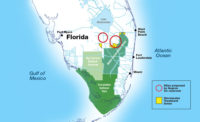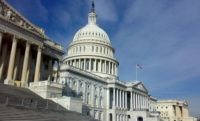Heavy rainfall this spring overwhelmed Everglades infrastructure and required operators to discharge nutrient-laden water from Lake Okeechobee to South Florida’s east and west coasts. The resulting toxic algal blooms are fouling Florida’s coast, killing wildlife, driving away vacationers and local beachgoers and threatening public health.
In response, the South Florida Water Management District is using every available structure and pump to move additional water south from the lake, and the agency has expedited approval of work on a key component of the Central Everglades Planning Project.
“This year is historic,” Caloosahatchee Waterkeeper John Cassani says. “I’ve worked on the river for 40 years; I’ve never seen anything like this, where 65 miles of the river has cyanobacteria blooms in one stage or another.”
In early August, the water management district approved the award of an 18-month, $12.6-million project to Daniel O’Connell’s Sons for construction of the S-333N water-control structure in the project, adjacent to the existing S-333 structure in western Miami-Dade County. The addition will nearly double, to 2,500 cu ft per second, the amount of clean, fresh water that can be moved south from Water Conservation Area 3A.
Concurrently, the district is expediting action to relocate 6 miles of power lines along the Old Tamiami Trail to prepare for rebuilding of the road to allow sheetflow of water from a conservation area into Everglades National Park. The agency also is planning an early-2019 award for construction of water control structures and more than 16 miles of embankments for the C-43 West Basin Storage Reservoir in Hendry County. The state is also moving forward with a $1-billion water-storage project, the A-2 Reservoir, in the Everglades Agricultural Area south of Lake Okeechobee to reduce harmful lake discharges to the Caloosahatchee and St. Lucie estuaries.
Two kinds of algae are driving the crisis: Karenia brevis, which causes “red tide,” and cyanobacteria, also called “blue-green algae.” K. brevis, a marine alga, is “a naturally occurring organism,” that has been present for at least 500 years, says Larry E. Brand, professor of marine biology at the University of Miami. The current bloom appeared in November 2017 and is now stretched along some 145 miles of Florida’s southwest coastline, the state’s Fish and Wildlife Commission says.
No Choice But To Release Water
Blue-green algae began appearing in Lake Okeechobee in May and June following unusually heavy rains, which endangered the Herbert Hoover Dike that impounds the lake. “The Corps of Engineers really has no choice but to release that water when the lake gets too high,” Brand says. The blue-green algae flows down the Caloosahatchee River to the west and the St. Lucie Canal to the east.
Brand adds that when the plume of freshwater algae reaches the Gulf of Mexico it dies, releasing even more nutrients. Where the algae blooms meet, they react with each other and make the problem worse, Cassani says. “We have this fairly large overlap now, red tide and cyanobacteria.”
And the red tide problem is getting worse, Brand says. In a study of two sets of algal-monitoring data separated by 50 years, he concluded, “today the average abundance of red tide is 15 times more than it was 50 years ago.” The solution, he admits, is politically unrealistic: “Convert the agricultural lands back into wetlands,” and allow the Everglades to clean the water. Failing that, the infrastructure of the Comprehensive Everglades Restoration Plan must do the job.





Post a comment to this article
Report Abusive Comment